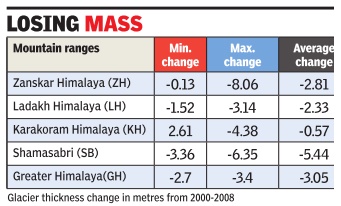Jammu & Kashmir: Ecological issues
This is a collection of articles archived for the excellence of their content. |
Glaciers, rivers
Shrinking glaciers cut J&K water flow
Jayashree Nandi, Shrinking glaciers cut J&K water flow , August 14, 2017: The Times of India

The impact of climate change is being felt in Kashmir as snowfall has reduced over the years and glaciers are losing mass leading to reduced flows in Chenab, Jhelum and Indus.
A recent research has highlighted Srinagar was facing one of the highest black carbon pollution (caused due to incomplete combustion of fossil fuel), nearly as much as in Delhi, one of the most polluted cities in the world.
Studies by Kashmir University's department of earth sciences have highlighted severity of water stress and poor air quality in the region. According to Shakil A Romshoo, head of the department, loss of glaciers in Upper Indus Basin (Hindukush, Karakoram and Himalayan ranges) could be highest among those in Kashmir.
Rearchers Romshoo and Khalid Omar Murtaza studied the health of nine “benchmark“ glaciers in Himalayas between 1980 and 2013. The analysis showed the glaciers in Lidder valley have shrunk by 17%. The annual air temperature has shown increasing trends while a decrease in precipitation has also been noticed. The total area of the nine benchmark glaciers in 1980 was 29.01square kilometres, and it reduced to 23.81 square kilometres in 2013.
However, the melting of glaciers have not raised the water level in the rivers. “It depends where you are measuring the discharge and in what climate system. If the catchment area has 100% glacier cover, then higher melting will lead to higher discharge. But such catchments hardly exist. As glacier cover decreases, flow regime is controlled by precipitation.Higher melting is linked to reduced snow cover which covers a wider area in high altitude catchment. So reduced snow cover and precipitation is leading to reduced discharge downstream,“ said Renoj Thayyen, scientist at National Institute of Hydrology.
Romshoo highlighted these concerns at a meeting of the Indus basin countries organised by the International Water Management Institute in Colombo. “If this trend of recession continues, it may pose a serious threat to the availability of water for irrigation, hydropower, horticulture and recreational use,“ he said. Romshoo said a related worry was the shifting of peak rainfall discharge from summer to spring. “But the shifting of hydrographic cycle to spring would have long term consequences for agriculture in UIB unless the government initiates creating water storage infrastructure in the form of dams to store spring water.“ said Romshoo.